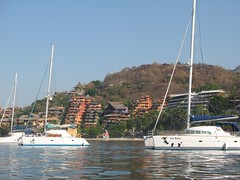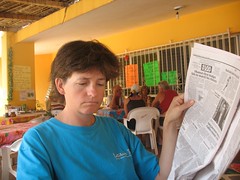“Is that French?”
“Yeah, but I think it's Canada. Don't get excited. We're not there yet.”
~ dialog between two cruisers halfway from Mexico to French Polynesia
In Part 1 of this series about Communicating on the High Seas, I talked about VHF. While good for short range, VHF is seriously hampered by distance and physical obstacles such as mountains, buildings, and cruise ships. For long range, we rely on our SSB.
Single Side Band (SSB) radio seems like an expensive and persnickity technology to add to your boat. I readily admit that for weekend cruisers – perhaps even for coastal cruising – an SSB isn't really a critical necessity. If you rarely leave sight of land and that land is the U.S., Canada, or other countries with extremely well deployed and powerful marine VHF radio networks, you can forego the hassle and expense. On the other hand, an SSB brings a few really nice advantages to the boat that even in the Pacific Northwest and Mexico, we on Don Quixote were very glad to have. For those planning longer, transoceanic journies, an SSB is about as non-optional a piece of equipment as radar.
Our ICOM802 has proven a solid, reliable addition to the boat. Other cruisers will swear by their brand or model. I can't speak to the comparative value in SSB models. I just know two really important bits about Don Quixote's radio:
It works.
It is load.
Loud in SSB terms is a Good Thing. Generally, it means that the unit is well-powered, the settings are configured correctly, and – probably most importantly – the unit is grounded properly and has a well founded antenna. Folks troubleshooting SSB radios say that grounding and antenna are the two most common issues with these units. I can't tell you how many stories we've heard about $1000 electronic paperweights revived by changing the connections someplace deep in the bowels of the boat. Troubleshooting an SSB is about the fastest way to go mad on a boat as comes immediately to mind.
Because of these known issues, DrC took two measures which he offers on the off chance that one or both are the magical sauce which blessed us with a loud SSB:
Copper Foil – He lined the entire port bilge with copper foil and connected it to the SSB ground.
Split Lead Antenna - I'll defer to Panbo this subject. DrC installed an Gam split lead antenna on the port side spreader. Again, don't know why or how, but our system works. This could be the mojo.
Now that you have an SSB, some pro with squinty eyes and leather skin installed it, and you've copper-plated the hull, let's talk about why an SSB is a must-have on Don Quixote.
Weather – You North Americans are so spoiled. I remember the days when we could just tune the VHF to the US or Canadian weather channel and get an up-to-date report on weather conditions. Not so much any place else. I bet Europe broadcasts weather, too... probably other folks as well. Mexico doesn't bother – even assuming you speak Spanish well enough to understand it – and obviously no one is keeping station in the middle of the Pacific. Fortunately, pretty much every report, fax, GRIB, and weather service is available over the SSB. What doesn't publish directly over the radio waves, you can subscribe to indirectly via a mail service such as WinLink or SailMail.
Email – Which gets me to my favorite SSB feature, electronic messaging. Drop yourself mentally back to the days of 2400 baud dial-up modems, and you can honestly say that your boat has “access” to the Internet. Text only, true. Yet, do not discount how useful it is to exchange messages with family, destination contacts, and the world. If you're clever, you can set up your blog, Facebook account, Twitter, and other social media to accept content from your SSB address, enabling you to continue to broadcast the contents of your lunch to all and sundry from the middle of nowhere.
Cruiser Nets – Everywhere we've been or plan to visit, we have been able to participate in regular cruiser nets. These daily events serve cruisers as combined weather report, social opportunity, and safety net. Cruisers exchange information on conditions, arrange meetups, and coordinate passages. Where we personally found a net the most useful was during the hurricane season in the Sea of Cortez. However, Pacific Puddle Jumpers from prior years report that the PPJ net will become our lifeline during our months on the Coconut Milk Run. It surprises us not at all, and we're looking forward to sharing our experiences over the airwaves with our fellow jumpers.
Entertainment – And if all that were insufficient to convince you of the usefulness of an SSB, you can always listen to the radio as … yes... a radio. If you really want to listen to the news, you can. If you really want to.
“Yeah, but I think it's Canada. Don't get excited. We're not there yet.”
~ dialog between two cruisers halfway from Mexico to French Polynesia
In Part 1 of this series about Communicating on the High Seas, I talked about VHF. While good for short range, VHF is seriously hampered by distance and physical obstacles such as mountains, buildings, and cruise ships. For long range, we rely on our SSB.
Single Side Band (SSB) radio seems like an expensive and persnickity technology to add to your boat. I readily admit that for weekend cruisers – perhaps even for coastal cruising – an SSB isn't really a critical necessity. If you rarely leave sight of land and that land is the U.S., Canada, or other countries with extremely well deployed and powerful marine VHF radio networks, you can forego the hassle and expense. On the other hand, an SSB brings a few really nice advantages to the boat that even in the Pacific Northwest and Mexico, we on Don Quixote were very glad to have. For those planning longer, transoceanic journies, an SSB is about as non-optional a piece of equipment as radar.
Our ICOM802 has proven a solid, reliable addition to the boat. Other cruisers will swear by their brand or model. I can't speak to the comparative value in SSB models. I just know two really important bits about Don Quixote's radio:
It works.
It is load.
Loud in SSB terms is a Good Thing. Generally, it means that the unit is well-powered, the settings are configured correctly, and – probably most importantly – the unit is grounded properly and has a well founded antenna. Folks troubleshooting SSB radios say that grounding and antenna are the two most common issues with these units. I can't tell you how many stories we've heard about $1000 electronic paperweights revived by changing the connections someplace deep in the bowels of the boat. Troubleshooting an SSB is about the fastest way to go mad on a boat as comes immediately to mind.
Because of these known issues, DrC took two measures which he offers on the off chance that one or both are the magical sauce which blessed us with a loud SSB:
Copper Foil – He lined the entire port bilge with copper foil and connected it to the SSB ground.
Split Lead Antenna - I'll defer to Panbo this subject. DrC installed an Gam split lead antenna on the port side spreader. Again, don't know why or how, but our system works. This could be the mojo.
Now that you have an SSB, some pro with squinty eyes and leather skin installed it, and you've copper-plated the hull, let's talk about why an SSB is a must-have on Don Quixote.
Weather – You North Americans are so spoiled. I remember the days when we could just tune the VHF to the US or Canadian weather channel and get an up-to-date report on weather conditions. Not so much any place else. I bet Europe broadcasts weather, too... probably other folks as well. Mexico doesn't bother – even assuming you speak Spanish well enough to understand it – and obviously no one is keeping station in the middle of the Pacific. Fortunately, pretty much every report, fax, GRIB, and weather service is available over the SSB. What doesn't publish directly over the radio waves, you can subscribe to indirectly via a mail service such as WinLink or SailMail.
Email – Which gets me to my favorite SSB feature, electronic messaging. Drop yourself mentally back to the days of 2400 baud dial-up modems, and you can honestly say that your boat has “access” to the Internet. Text only, true. Yet, do not discount how useful it is to exchange messages with family, destination contacts, and the world. If you're clever, you can set up your blog, Facebook account, Twitter, and other social media to accept content from your SSB address, enabling you to continue to broadcast the contents of your lunch to all and sundry from the middle of nowhere.
Cruiser Nets – Everywhere we've been or plan to visit, we have been able to participate in regular cruiser nets. These daily events serve cruisers as combined weather report, social opportunity, and safety net. Cruisers exchange information on conditions, arrange meetups, and coordinate passages. Where we personally found a net the most useful was during the hurricane season in the Sea of Cortez. However, Pacific Puddle Jumpers from prior years report that the PPJ net will become our lifeline during our months on the Coconut Milk Run. It surprises us not at all, and we're looking forward to sharing our experiences over the airwaves with our fellow jumpers.
Entertainment – And if all that were insufficient to convince you of the usefulness of an SSB, you can always listen to the radio as … yes... a radio. If you really want to listen to the news, you can. If you really want to.

